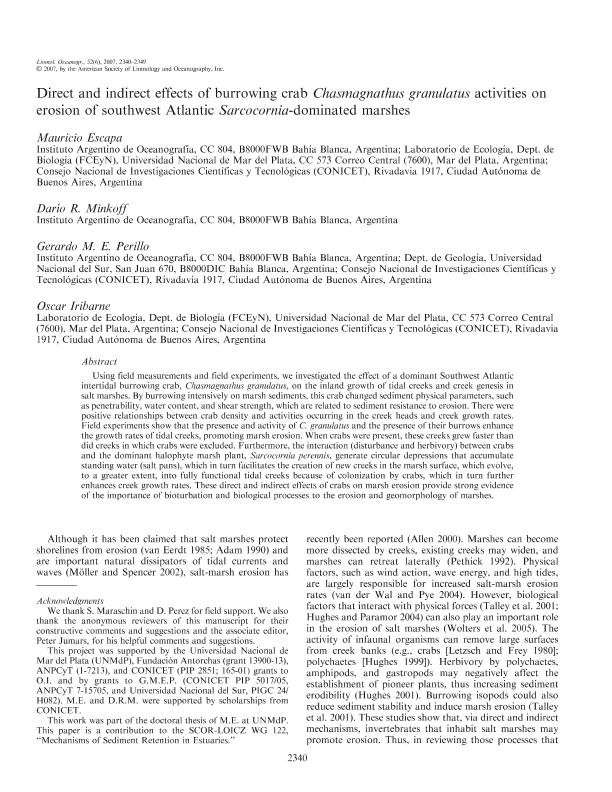Artículo
Direct and indirect effects of burrowing crab activities on erosion of southwest Atlantic Sarcocornia-dominated marshes
Escapa, Carlos Mauricio ; Minkoff, Dario Roberto
; Minkoff, Dario Roberto ; Perillo, Gerardo Miguel E.
; Perillo, Gerardo Miguel E. ; Iribarne, Oscar Osvaldo
; Iribarne, Oscar Osvaldo
 ; Minkoff, Dario Roberto
; Minkoff, Dario Roberto ; Perillo, Gerardo Miguel E.
; Perillo, Gerardo Miguel E. ; Iribarne, Oscar Osvaldo
; Iribarne, Oscar Osvaldo
Fecha de publicación:
12/2007
Editorial:
Amer Soc Limnology Oceanography
Revista:
Limnology and Oceanography
ISSN:
0024-3590
Idioma:
Inglés
Tipo de recurso:
Artículo publicado
Clasificación temática:
Resumen
Using field measurements and field experiments, we investigated the effect of a dominant Southwest Atlantic intertidal burrowing crab, Chasmagnathus granulatus, on the inland growth of tidal creeks and creek genesis in salt marshes. By burrowing intensively on marsh sediments, this crab changed sediment physical parameters, such as penetrability, water content, and shear strength, which are related to sediment resistance to erosion. There were positive relationships between crab density and activities occurring in the creek heads and creek growth rates. Field experiments show that the presence and activity of C. granulatus and the presence of their burrows enhance the growth rates of tidal creeks, promoting marsh erosion. When crabs were present, these creeks grew faster than did creeks in which crabs were excluded. Furthermore, the interaction (disturbance and herbivory) between crabs and the dominant halophyte marsh plant, Sarcocornia perennis, generate circular depressions that accumulate standing water (salt pans), which in turn facilitates the creation of new creeks in the marsh surface, which evolve, to a greater extent, into fully functional tidal creeks because of colonization by crabs, which in turn further enhances creek growth rates. These direct and indirect effects of crabs on marsh erosion provide strong evidence of the importance of bioturbation and biological processes to the erosion and geomorphology of marshes.
Palabras clave:
Crab
,
Bioturbation
,
Channels
,
Effect
Archivos asociados
Licencia
Identificadores
Colecciones
Articulos(IADO)
Articulos de INST.ARG.DE OCEANOGRAFIA (I)
Articulos de INST.ARG.DE OCEANOGRAFIA (I)
Articulos(IIMYC)
Articulos de INSTITUTO DE INVESTIGACIONES MARINAS Y COSTERAS
Articulos de INSTITUTO DE INVESTIGACIONES MARINAS Y COSTERAS
Citación
Escapa, Carlos Mauricio; Minkoff, Dario Roberto; Perillo, Gerardo Miguel E.; Iribarne, Oscar Osvaldo; Direct and indirect effects of burrowing crab activities on erosion of southwest Atlantic Sarcocornia-dominated marshes; Amer Soc Limnology Oceanography; Limnology and Oceanography; 52; 6; 12-2007; 2340-2349
Compartir
Altmétricas



